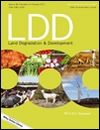 Another editor has resigned from an earth science journal following allegations over citation irregularities, which also took down its editor-in-chief.
Another editor has resigned from an earth science journal following allegations over citation irregularities, which also took down its editor-in-chief.
According to Land Degradation & Development website, editor Paolo Pereira has stepped down from the journal. The journal does not say why, and a spokesperson for publisher Wiley did not elaborate. The website has included the announcement about Pereira above a longer statement regarding citation issues at the journal, which saw its Impact Factor rise dramatically from 3.089 in 2014 to 8.145 in 2015.
Pereira — based at Mykolas Romeris University in Lithuania — has co-authored multiple papers with Artemi Cerdà of the University of Valencia in Spain, who stepped down as editor-in-chief of the journal earlier this year.
In February, Land Degradation & Development was contacted by another publisher, who had been investigating citation irregularities between its journals and Land Degradation & Development. Cerdà temporarily stepped down while LDD conducted its own investigation; last month, the journal asked him to step down permanently. Cerdà has also resigned from three journals published by European Geosciences Union/Copernicus.
Cerdà has also resigned from the editorial boards of Geoderma and Catena, published by Elsevier.
As part of its investigation, the European Geosciences Union considered the work of Pereira, who was an editor at Solid Earth, and reviewed papers for that journal and Earth Surface Dynamics (ESurf). The EGU concluded that only Cerdà had manipulated citations. Regarding Pereira’s efforts, the publisher found:
As topical editor, Paulo Pereira handled 42 SE manuscripts. For 4 manuscripts he suggested to include in total 16 additional references to the journals LDD (7), SOIL (1), and others (8). From these suggestions, 6 were included by the authors of 3 manuscripts. These inclusions reference to LDD (2), SOIL (1), and others (3). His maximum was 10 suggestions for a manuscript.
As reviewer, Paulo Pereira worked on 17 manuscripts in the journals ESurf (2) and SE (15). For 3 manuscripts he suggested to include in total 16 additional references to the journals LDD (1), SOIL (2), SE (6), and others (7). His maximum was 7 suggestions for a manuscript.
Last month, we spoke to Cerdà at length; he defended his actions, saying he never forced authors to add citations to their papers (merely made suggestions of other references they should consult for background). He claimed he was being unfairly accused by journals who had to explain why their impact factors had risen dramatically.
Like Retraction Watch? Consider making a tax-deductible contribution to support our growth. You can also follow us on Twitter, like us on Facebook, add us to your RSS reader, sign up on our homepage for an email every time there’s a new post, or subscribe to our daily digest. Click here to review our Comments Policy. For a sneak peek at what we’re working on, click here.
Like for the Cerda case, I find bizarre that he suggested so many new citations, and so many for the same journals. This is really not something I am comfortable with.
However, in the end, as an editor, he was involved in adding 6 citations (we don’t know how many as a reviewer but maximum would be 16).
What fraction of the IF increase does this explain? I mean, is it possible that something else
is going on?
https://twitter.com/ArtemioCerda/status/722448926209675264/photo/1
My question would be – how much does this differ from other reviewers? Do Pereira’s recommendations different (statistically significantly) from the number of papers recommended by other reviewers? I recently recommended three papers (three different journals) to an author as something they should at least read, and all three were then included in citations for the next draft… I could well imagine that over time someone could look back and infer a pattern from my reviewing that was stochastic, not intentional. Whereas Cerda’s numbers I *would* expect to be found to be statistically significantly abnormal.
The report by the Publisher contains a list of several of the editors, and Pereira isn’t ‘abnormal’.
Is it wrong for a reviewer to suggest additional reading materials to the authors of articles under review?
Only recently, I urged the author of one article from an East African country to peruse four additional papers to beef up the author’s introduction.
Was this advice misplaced?
[I am NOT an editor of the journal, but once in a while I am asked to review some articles being considered for publication]
Kindly advise so that in the future I behave differently…
No, it is not wrong as such.
You may get some questions, however, if you consistently suggest additional ‘reading’ materials that are primarily from the journal(s) where you are an Editor or Editorial Board member, and/or papers that happen to have your name as one of the authors.
It is not wrong to suggest references in a review process. But in this case reviewer systematically request authors to cite references to particular journal without strong reason and never provided any useful review. In this example, Artemi merely suggested citing references without reviewing the paper http://www.soil-journal.net/1/287/2015/soil-1-287-2015-discussion.html
The updated Impact Factor of Land Degradation and Development has been released. According to the Journal Citation Reports®, published by Clarivate Analytics in June 2017, the new Impact Factor is 9.787. LDD journal now ranks 1/34 (Q1) in the ‘Soil Science’ category.
Mary,
What is the source of the new IF information that you provided in your reply for LDD? I still don’t see that on the journal homepage. Could you please refer a source? Thanks!
I don’t see the IF of LDD in the official website anymore
http://onlinelibrary.wiley.com/journal/10.1002/(ISSN)1099-145X
You may find this of interest: http://retractionwatch.com/2017/06/19/journal-hit-citation-scandal-named-among-top-field/